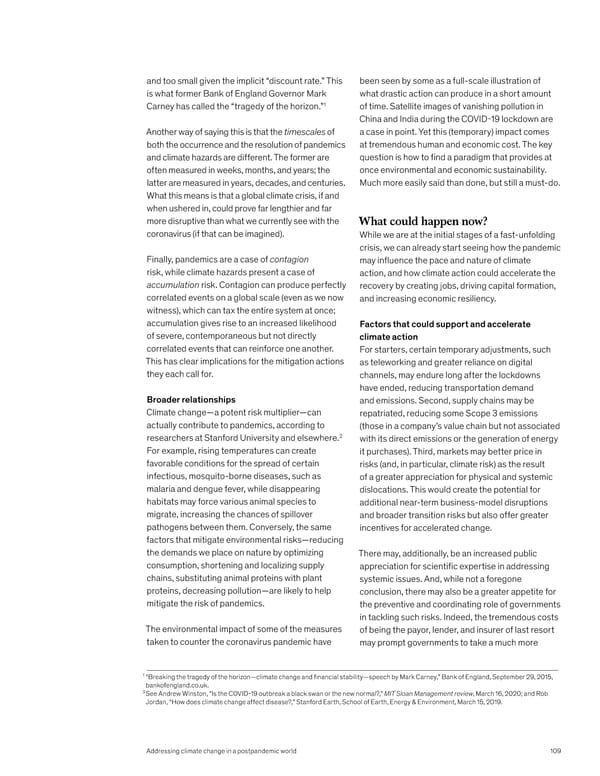and too small given the implicit “discount rate.” This been seen by some as a full-scale illustration of is what former Bank of England Governor Mark what drastic action can produce in a short amount Carney has called the “tragedy of the horizon.”1 of time. Satellite images of vanishing pollution in China and India during the COVID-19 lockdown are Another way of saying this is that the timescales of a case in point. Yet this (temporary) impact comes both the occurrence and the resolution of pandemics at tremendous human and economic cost. The key and climate hazards are different. The former are question is how to find a paradigm that provides at often measured in weeks, months, and years; the once environmental and economic sustainability. latter are measured in years, decades, and centuries. Much more easily said than done, but still a must-do. What this means is that a global climate crisis, if and when ushered in, could prove far lengthier and far more disruptive than what we currently see with the What could happen now? coronavirus (if that can be imagined). While we are at the initial stages of a fast-unfolding crisis, we can already start seeing how the pandemic Finally, pandemics are a case of contagion may influence the pace and nature of climate risk, while climate hazards present a case of action, and how climate action could accelerate the accumulation risk. Contagion can produce perfectly recovery by creating jobs, driving capital formation, correlated events on a global scale (even as we now and increasing economic resiliency. witness), which can tax the entire system at once; accumulation gives rise to an increased likelihood Factors that could support and accelerate of severe, contemporaneous but not directly climate action correlated events that can reinforce one another. For starters, certain temporary adjustments, such This has clear implications for the mitigation actions as teleworking and greater reliance on digital they each call for. channels, may endure long after the lockdowns have ended, reducing transportation demand Broader relationships and emissions. Second, supply chains may be Climate change—a potent risk multiplier—can repatriated, reducing some Scope 3 emissions actually contribute to pandemics, according to (those in a company’s value chain but not associated researchers at Stanford University and elsewhere.2 with its direct emissions or the generation of energy For example, rising temperatures can create it purchases). Third, markets may better price in favorable conditions for the spread of certain risks (and, in particular, climate risk) as the result infectious, mosquito-borne diseases, such as of a greater appreciation for physical and systemic malaria and dengue fever, while disappearing dislocations. This would create the potential for habitats may force various animal species to additional near-term business-model disruptions migrate, increasing the chances of spillover and broader transition risks but also offer greater pathogens between them. Conversely, the same incentives for accelerated change. factors that mitigate environmental risks—reducing the demands we place on nature by optimizing There may, additionally, be an increased public consumption, shortening and localizing supply appreciation for scientific expertise in addressing chains, substituting animal proteins with plant systemic issues. And, while not a foregone proteins, decreasing pollution—are likely to help conclusion, there may also be a greater appetite for mitigate the risk of pandemics. the preventive and coordinating role of governments in tackling such risks. Indeed, the tremendous costs The environmental impact of some of the measures of being the payor, lender, and insurer of last resort taken to counter the coronavirus pandemic have may prompt governments to take a much more 1 “Breaking the tragedy of the horizon—climate change and financial stability—speech by Mark Carney,” Bank of England, September 29, 2015, bankofengland.co.uk. 2 See Andrew Winston, “Is the COVID-19 outbreak a black swan or the new normal?,” MIT Sloan Management review, March 16, 2020; and Rob Jordan, “How does climate change affect disease?,” Stanford Earth, School of Earth, Energy & Environment, March 15, 2019. Addressing climate change in a postpandemic world 109
 What Now? Page 110 Page 112
What Now? Page 110 Page 112